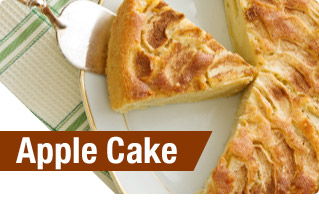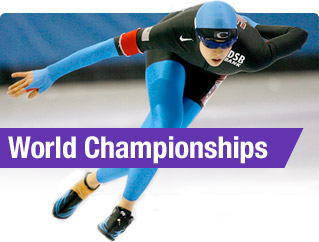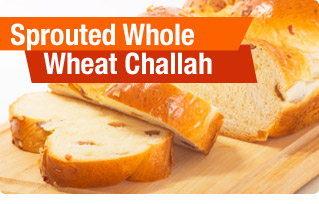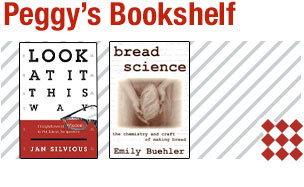A MESSAGE FROM PEGGY
I completed my week–long “Science of Bread” class at the John C. Campbell Folk School in Brasstown, NC. It was a great experience. I got to bake with our sprouted flour all week and never made a bad loaf of bread! Emily Buehler, our instructor, was very informative and a real gem.
All the wonderful tips learned I’ll be sharing with you in upcoming newsletters. We made French baguettes, sourdough boules, ciabatta, focaccia, sticky buns, challah, brioche, rustic and country loaves, sticky buns, and even some sourdough dog biscuits (my bulldog loved them!). It snowed about six inches the first night I was there. The school is nestled in the Appalachian Mountains so the scenery was breathtaking.
Maria Lamb, our wonderful Olympic speed skater we sponsor (with lots of sprouted flours and grains) has qualified to race at the World Allround Championships in Calgary this month. Her update is included. If you get the opportunity to send her a word of encouragement she’d love to hear from you at maria@marialamb.com
My bread baking instructor Emily Buehler knows all the how–tos when it comes to baking great breads. She has written a wonderful book that I’ve included in Peggy’s Bookshelf. It’s available at www.amazon.com. The evening of our last day of class we had baked lots of breads for everyone attending the school that week (over 200 folks) to enjoy, as well as admire. During Emily’s presentation that evening she shared The Bread Baker’s Blessing which I shall now share with you.
The Bread Baker’s Blessing
May the dough rise to meet you,
May the cloud of flour be always at your back,
May the oven shine warm upon your face,
May the steam fall softly upon your loaves,
And until we meet again,
May God punch–and–fold you in the palm of His hand.*
Back to top

- ½ cup whole wheat flour
- ¼ cup spelt flour
- ¾ teaspoon baking powder
- pinch of salt
- 4 large apples
- 2 large eggs, at room temperature
- ¾ cup palm sugar
- 3 tablespoons dark rum
- ½ teaspoon vanilla extract
- 4 tablespoons butter and 4 tablespoons coconut
oil, melted and cooled to room temperature
- Preheat the oven to 350ºF and adjust the oven
rack to the center of the oven.
- Heavily butter an 8- or 9-inch springform pan
and place it on a baking sheet.
- In a small bowl, whisk together the flours,
baking powder, and salt.
- Peel and core the apples, then dice them
into 1–inch pieces.
- In a large bowl, beat the eggs until foamy
then whisk in the sugar, then rum and vanilla.
Whisk in half of the flour mixture, then gently
stir in half of the melted butter.
- Stir in the remaining flour mixture, then
the rest of the butter.
- Fold in the apple cubes until they’re
well–coated with the batter and scrape them
into the prepared cake pan.
- Bake the cake for 50 minute to 1 hour, or until a
knife inserted into the center comes out clean. Let the
cake cool for 5 minutes, then run a knife around the edge
to loosen the cake from the pan and carefully remove the
sides of the cake pan, making sure no apples are
stuck to it.
Back to top

I am in the final weeks of preparation for the upcoming World Allround Championships to be held in Calgary February 12–13 where I will be one of two American women competing. World Allrounds is a grueling two days of racing a total of four races–500m, 3000m, 1500m and 5000m–it is your combined time of the four races that decides the overall placement. World Allrounds is the Tour de France, or the supper bowl of long track speedskating–it is the most prestigious race to win. You can be a World Sprint Champion, or Olympic Champion, but to be World Allround Champion is just something a little different. If I could choose one race to win in my career, it would be World Allrounds.
This will be my 6th World Allround Championships, and I am honored, nervous, and excited all at the same time. This racing season has been full of all kinds of challenges–from coaching changes, injuries, and overtraining, I have not raced as well as I would have liked at times. It is easy to get frustrated and just try too hard at times, usually only making things worse. As a very wise friend of mine recently told me “sometimes, at the biggest moments of your life, you have to try less hard; you have to forget how much you want something, and just let yourself do what you know how to do”. So, I’ve been working on relaxing, finding that perfect combination of power and rhythm in my skating, and just letting myself enjoy what I love, to skate! And guess what? It’s been working! I have been feeling better and skating better this last week, and I still have all the most important races ahead of me. So, I intend to put all that has happened behind me, take what I have and use the upcoming weeks to learn all I can, and skate the best races I am capable of. And, I’ll try not to forget to enjoy it!
Before I set off to race, a huge thanks to everyone who has helped and supported me–my coaches, teammates, family, friends, and of course To Your Health Sprouted Flour! Thank you Peggy and Jeff for supplying me with the all of the wonderful flour and grains that have helped fuel my racing and training all year! For this months recipe I have something a little different–my favorite pre–race dinner.
Back to top

Sprouted Whole Wheat Challah
I like to bake the braided challah dough in 2 loaf
pans or 1 large and 4 small.
- 1 ½ cups lukewarm water
- 5 large egg yolks (reserve one white for bread
glaze or use one whole egg for glaze)
- 1 ½ teaspoon sea salt
- ¼ cup coconut oil
- ¼ cup honey
- 4 ½ cups organic sprouted whole wheat flour,
or any other flour
- 1 tablespoon active dry yeast
- Optional topping: sesame seeds, poppy seeds,
anise seeds, dried rosemary or dill
Place all ingredients in the bread machine and process on the dough cycle (my machine requires the liquid ingredients to be added first). Alternatively, mix the liquid ingredients in a stand mixer or by hand then add in the flour and knead until a smooth, uniform dough is formed. Allow to rise for 2 hours or until it has doubled in bulk.
Preheat oven to 350 degrees. Lightly flour a work surface. Divide the dough in half and shape as desired. If not using loaf pans, you can place the braided dough on parchment-lined baking sheets. Cover the dough and allow to rise for 45 minutes.
Whisk the reserved egg white with a tablespoon of water in a small bowl. If you are using white flour for the challah, whisk a whole egg for the glaze to give the dough more color. Brush the challah with the glaze and sprinkle with desired topping. Bake for 30 minutes—less for smaller loaves—until the loaves sound hollow when tapped on the bottom or registers 195 degrees with an instant read thermometer. Let cool on a wire rack
Back to top
TYH Tips for Baking:
Let’s talk SALT this month, especially when it comes to baking. Salt enhances the flavor of any bread or baked good. I prefer the taste of sea salt or Celtic salt, but it needs to be a fine grind before adding it to a recipe. In bread–baking it’s best not to use salt that contains a free–flowing agent or iodine, as these added ingredients may interrupt or play a part in the chemistry of your dough reactions.
It is important to add salt (in bread-baking) because (excerpted from Wild Sourdough by: Yoke Mardewi):
- Salt controls your fermentation, allowing you to have a long fermentation period.
- Salt increases the strength of the gluten by tightening the gluten structure. A salt-less dough will be slack and sticky and the bread volume will be poor.
- Salt enhances the color of your crumb and increases its moistness.
- You can reduce the amount of salt to a minimum of 1 percent. That is about 2 teaspoons of sea salt per kilogram of flour.
Back to top



Back to top
|